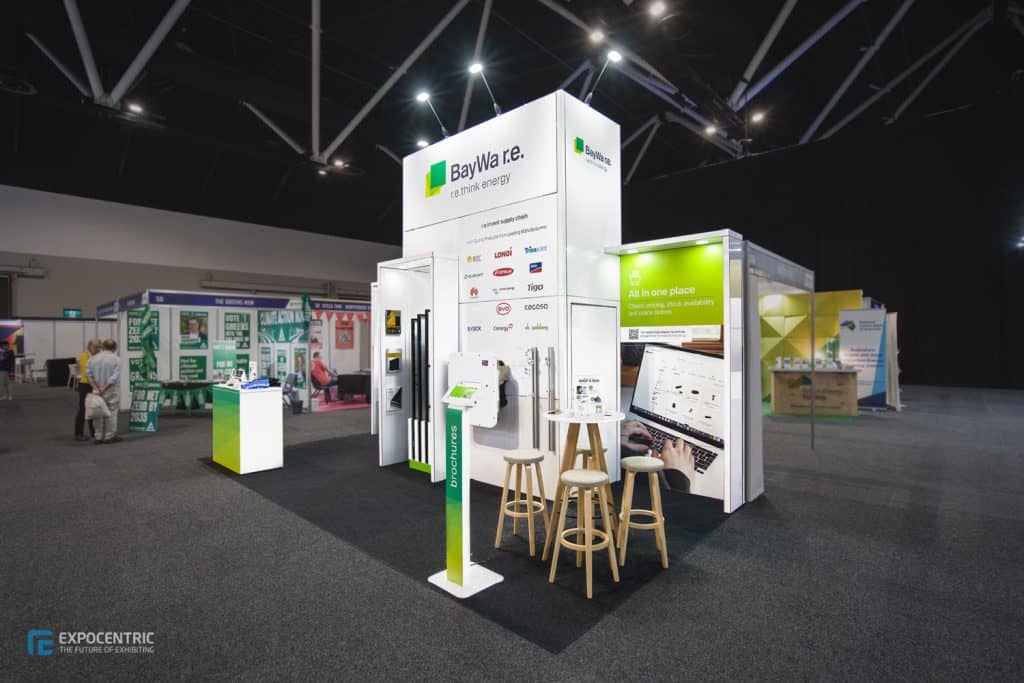Whilst we’re aware of the impact that trade shows have on our company’s performance and revenue, understanding should be considered for the role that our marketing strategy plays. The performance of your company both at the exhibition and into the future in part relies on the strength of the marketing campaign surrounding it. By ‘surrounding it’, we don’t just mean in the lead up to the event, in fact we mean what you are doing from the moment you sign the contract through to twelve months beyond the trade show dates.
To begin with, what is trade show marketing? Trade show marketing is the efforts your company contributes at industry events to showcase your products or services. The marketing strategy is the detailed approach your company coordinates to ensure all marketing efforts are unified to meet the businesses predetermined goals.
In short it dictates a successful event. Understandably a marketing strategy can be intimidating for some. We have broken it down into five bite size pieces that any beginner marketer can pick up and roll out, but first understanding should be confirmed for the businesses objectives.

The Objective
A simple word yet critical ingredient to hosting a successful exhibition stand. As soon as (or even before) the stand contract has been signed consideration should be given to the objective behind exhibiting. As companies invest significant resources into a single event, it’s important that all parties within the company are unified on the primary marketing goals of the event. Whilst ‘making more money’ and ‘making sales’ is likely what your company is striving for, the marketing objectives should look to facilitate how these sales can be made.
Some objectives that look to facilitate the how include:
- Strengthening relationships with existing customers
- Connecting with potential customers and generating new leads
- Facilitating a product launch
- Generate sales whilst on the stand
- Creating new business contacts
Whilst these objectives may not align with every company, it’s important that successful business comes through the alignment of common goals that can be created into actionable tasks as part of our trade show marketing timeline.
The Timeline
Here’s a secret; the ‘trade show marketing strategy’ becomes 90% less daunting once the timeline is in place. In other words the timeline soon becomes the bible for trade show marketing detailing what, where and when each piece of content should be distributed. So where to begin?
The timeline can be divided in three stages starting the day you sign the contract, after deciphering what the marketing and exhibiting goals are.

Stage 1: Pre-event marketing
If you’ve read our Seven Ways to Attract More Visitors to Your Exhibition Stand Blog, you’ll know that the one email the week before the exhibition won’t give you the results you’re looking for, instead consistent preparation will garner strong results. Throughout the pre-trade show marketing companies should consider all touch points to reach existing and potential audiences. The timeline should look to reach these audiences at least eight times ahead of the event with higher frequency in the lead up to the event. A typical pre-show timeline may include announcement timings as follows: 6-months,
4-months, 3-months, 2-months, 6-weeks, 4-weeks, 2-weeks and 1 week to go. Remember, pre-show marketing is often low cost as it is digital, so careful consideration should go into this approach to make a worthwhile impact.
Stage 2: At event marketing
With a strong marketing campaign in the lead up to the event it is important to maintain the momentum whilst being onside. Whilst the marketing is no longer digital, the trade event marketing should look to make a lasting impact on your target audience. Companies can look to tap into traditional above the line marketing practices whilst onsite for example distributing marketing materials. This should however be accompanied by digital marketing practises so not only the visitor, but your company walks away from the event with something. The harder your company works the marketing whilst being onsite, the easier the post-event marketing will be.


Stage 3: Post-event marketing
Just because the event ends doesn’t mean the trade show marketing ends alongside it. If the pre and at show marketing has been successful, your company should walk away with sales leads and new customers which can be tapped into post-event.
The Audience
Ahead of distributing any content, companies must first understand their audience. Understanding the makeup of an audience is a key element of a marketing plan for any business however when going to a trade show the target audience may be refined further. Typically businesses will look to target existing customers and potential customers.
The existing customer base will be made up of anyone who has purchased or utilised a service from your company before. These will be known as your warm or hot leads due to their existing relationship with your business. When directing marketing to this audience it is important to acknowledge this relationship. Existing clients often value the sense of feeling exclusive or known within a network. They may also required different information to potential audiences.
Potential audiences are those that aren’t currently within your network however align with the company and may be clients in the future. Whilst this audience may not already sit within your database, they may be reached through your existing network. Marketing to your existing audience should facilitate sharing content to the potential audience. This may be through share buttons within eDMs or content that can be easily shared to other networks through social media.
Through defining the correct audiences for your trade show marketing, you will be able to adapt the content distributed across the various platforms.


The Content
With the timeline finalised and the audiences confirmed, this piece of the marketing strategy shifts to the what – what content will be distributed throughout the three stages of the marketing timeline and where will the content be shared. There are two key approaches a company can take when marketing their trade show.
Digital Marketing
Digital marketing will host the majority of your marketing efforts through all three stages of your timeline. Digital marketing encourages the flexibility of segmenting information for different markets, as well as the speed and ease of distributing trade show marketing to mass audiences.
eDM distributions are a familiar and efficient way of reaching trade show attendees. Email marketing should follow the timeline detailed as part of the initial planning. Companies can look to feature a variety of key messages with the most important messages being distributed in higher frequency and closer to the trade show. Consideration should be given to utilising eDMs and their databases efficiently. Remember to segregate messaging to appropriate audiences, for example targeting existing clients who regularly purchase from you with different messaging to those who are on your database yet to be an active client.

Companies should look to tap into social media platforms to further increase the breadth of their audience. Consideration should be given to the type of messaging across the platforms to best suit their algorithms. LinkedIn may be used in the lead up to the event with more formal information as companies will be reaching a broader network within their existing industry. Comparatively, companies may look to use Instagram whilst onsite to create a sense of FOMO by highlighting what is happening on the stand at that particular time.
Through digital marketing companies should look to tap into the audiences of their networks for even greater exposure. For example, encourage guest speakers, the business owner, and other company ambassadors in the same industry to distribute communication about your attendance to their network. This is a cost efficient and effective way to further amplify your attendance ahead of going to the trade show.
The impact of digital marketing goes beyond the pre and post trade show marketing plan. Companies are encouraged to tap into digital marketing whilst being onsite. They can utilise digital marketing at the trade show as a means of direct selling, to capture leads and generate leads, schedule appointments and showcase the company’s products and services that cannot be brought to the trade show.


Traditional Marketing
Traditional marketing will likely be used whilst at the trade show, and encompasses the traditional marketing practises that companies perform in a face to face manner. Traditional marketing taps into having sales representatives onsite to liaise with existing customers whom they already have a rapport with and other trade show goers who may result in future leads.
Traditional marketing may also encompass marketing material or collateral brought onsite for customers to walk away with. Consideration should be given to the material created ensuring it includes recognisable branding, clear contact details and a space to find more information. The inclusion of QR codes within this content is often a successful trade show practice as it enables easy access for customers to read further information, whilst also a lead generation exercise for businesses as customers must provide details to learn more.


The Future
Sometimes the impact of trade show marketing makes its biggest impact after the event itself. Alike most companies, follow up is a key part of trade show marketing strategy. Follow up includes touching base with any new leads received from the booth. Not only does it strengthen any relationships made but can also positively impact the next event.
Another strategy that can be used after events includes the facilitation of other promotions. Companies may like to either extend their show specials after the show to their new leads, or provide an alternative incentive to shift their new lead into a sale.
Finally consideration should be given to the work done whilst on site that can set you up for up to 6 months worth of content after the event, which will form part of your marketing campaign. Read our blogs below on how to achieve this:
How to create 6 months of content with your Trade Show Stand (Part 1)
How to create 6 months of content with your Trade Show Stand (Part 2)
How to create 6 months of content with your Trade Show Stand (Part 3)
Developing a trade show marketing strategy plays an important role within your business model. Although it can be overwhelming at the start, use your timeline to break down the moving pieces into achievable steps to get the most out of your booth when on the trade show floor. Finally, don’t forget that your marketing doesn’t stop onsite, rather should continue into the months following the event.
This being said, if you’d prefer to stick to what you do best – running your business, we can support the marketing element for your major trade shows. Speak with our Expo Centric team who can provide you and your business all the marketing support you need to create an impact onsite and into the future.

